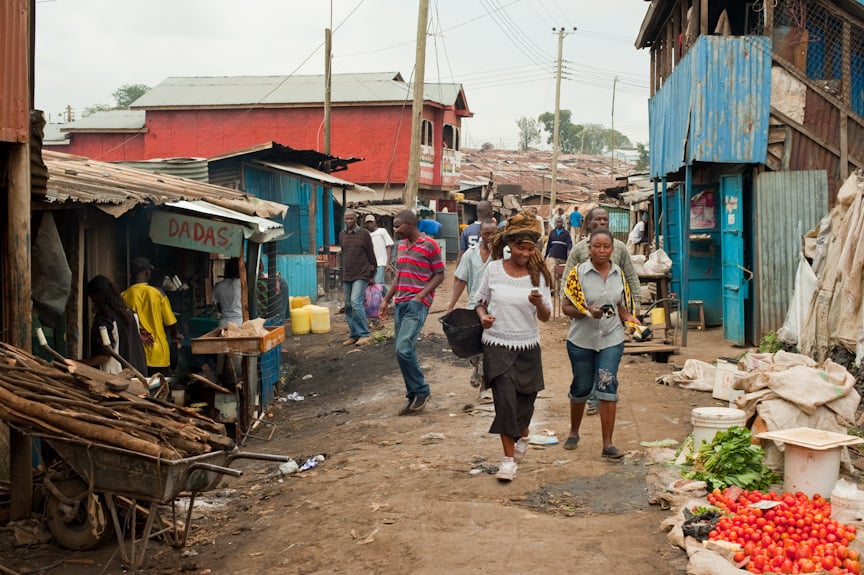"My customers are buying less and less; now I find that goods like vegetables do not sell out, they go into the next day. People's ability to buy these goods has really dropped,” Agolla, a mother of five, told IRIN.
Agolla managed to put her children through primary school but never earned enough to pay for secondary education.
"If I could afford to join a savings club [where members’ regular contributions are distributed on a rotational basis], I’d buy a variety of food to improve my stock and I would probably be selling more, and perhaps some of my children could go back to school," she said.
To fully understand Kenya's slums you have to wander down twisted, slippery, narrow aisles, jump over open sewers, take in the smells of one-year old garbage, taste stewed chicken beaks or roasted fish gills, and share in the fear of being bulldozed in the middle of the night. |
|
An Inventory of the Slums in Nairobi (Pamoja Trust) |
Pamela Anyango Odhiambo, 25, and a mother of five, says making ends meet gets harder and harder in Mathare.
"I think food prices have more than doubled within a short time; for example, with 300 shillings [US$4] I could feed my family for days. Now it is not even enough for one day," said Odhiambo, nursing two-month-old twins.
“Humanitarian crisis”
Slum-dwellers are among the Kenyans worst hit by high food prices, yet they receive far less humanitarian attention than other demographic groups. The poorest urbanites spend up to two-thirds of their income on staple foods alone.
"There is a humanitarian crisis in deprived informal settlements around the world, and one of the regions where this dynamic is playing out is in Kenya,” said Choice Okoro, advocacy and outreach officer for the UN Office for the Coordination of Humanitarian Affairs-Kenya.
“Urban poverty is set to be Kenya’s defining crisis over the next decade if it is not urgently addressed," she added.
Okoro said lack of recognition of slums and settlements as residential areas for city planning and budgeting purposes has meant that residents have been denied essential services provided to other residents.
"These include water, sanitation, electricity, garbage collection, health, education, access roads and transport," she said. "In turn, the services that property owners provide to tenants are often insufficient.
|
Photo: Caterina Pino/IRIN  |
| Fridah Awour Agolla at her vegetable stall in Mathare. She managed to put her children through primary school but never earned enough from the business to pay for secondary education |
In a September 2009 report, Oxfam-GB noted that the proportion of urban Kenyans unable to meet their nutritional and other basic requirements (the “absolute poor”) had declined over the past decade. “But this conceals the fact that the percentage share of the very poorest urban groups – defined as the ‘food poor’ [those unable to meet all nutritional needs due to expenditure on other basic non-food essentials] and ‘hardcore poor’ [unable to meet their basic food needs even by forgoing other essentials] has actually been increasing.” The report uses government thresholds, which define “nutritional needs” as 2,250 kilocalories per adult per day.
Upgrading
According to the UN Human Settlements Programme (UN-HABITAT), “Nairobi has some of the most dense, unsanitary and insecure slums in the world. Almost half of the population lives in over 100 slums and squatter settlements within the city, with little or inadequate access to safe water and sanitation.”
In an effort to address these problems, UN-HABITAT, the government and Nairobi City Council are working together on a Kenya Slum Upgrading Project (KENSUP), which focuses on improving infrastructure, initially in Kibera, one of Nairobi’s largest slums.
"Working together with the people of Kibera, we have identified the areas where the needs are greater, this is why we started working on water and sanitation,” said Joshua Kaiganaine, KENSUP’s programme manager, noting that $500,000 had so far been spent on water sanitation blocks, rubbish collection points and a 4km access road.
"We tackle waterborne diseases; later, we will move on to different areas like shelter and education but, for that we need to understand what people really can afford considering the majority of them have only casual jobs."
In the first phase of a KENSUP slum decanting initiative, in September 2009 some 1,300 residents of Kibera were moved to new apartment blocks with monthly rents of $20.
|
Photo: Jerry Riley/IRIN  |
| Efforts are ongoing to help food insecure slum dwellers, whose numbers are rising rapidly, with the UN, donors and NGOs running several food security and slum-upgrading programmes in informal settlements across the country |
Once it receives Cabinet approval, 20,000 slum residents will receive the equivalent of $20 a month. Depending on the outcome of the pilot scheme, the programme could be extended to other cities, such as Mombasa and Kisumu.
The money will be paid through a microfinance institution, Jami Bora, and via M-Pesa, an electronic cash transfer system operated by a mobile phone service provider.
"Targeting can be a sensitive issue,” World Food Programme (WFP) spokesman Peter Smerdon told IRIN, “as there will always be a bigger need that we can realistically target. Not everyone who feels they are eligible can be targeted, at least not in the pilot phase. So explaining how the project will be rolled out is a key part of the process.
"WFP, Oxfam and Concern will implement the project on behalf of the Government of Kenya," Smerdon said. "At the same time, however, we will be transferring the project to the Government, which will gradually take it over as part of its overall social protection strategy."
cp-js/am/mw
This article was produced by IRIN News while it was part of the United Nations Office for the Coordination of Humanitarian Affairs. Please send queries on copyright or liability to the UN. For more information: https://shop.un.org/rights-permissions





